
Many homeowners grapple with the major problem of unattractive fences, which can greatly influence the aesthetic appeal of their residence and potentially reduce its value. Simply applying a new layer of paint to the fence may not suffice in enhancing its appearance within your community. However, there is a highly effective solution for concealing these unsightly elements.
You can hide an ugly fence under a select number of plants. These include bougainvillea, star jasmine, honeysuckle, clematis, wisteria, etc. These plants grow in specific ways, from creeping vines to medium-height shrubs, and improve the overall look of the fence. This means that the property’s aesthetics can be improved, which can lead to an increase in the property’s value.
Everything you need to know about these plants is detailed below.
The best plants to hide an ugly fence
Finding the best plants to hide an ugly fence might be challenging for many. This is due to the large variety of plants available for purchase. Different plants also require different factors, and poorly cared for plants can end up withered and unsightly.
Here are some of the best plants to hide an ugly fence. They include in no particular order;
1. Bougainvillea

- Temperature: full sunlight
- Soil type: soil with good drainage
- pH; no particular preference
Bougainvillea is one of the best plants to hide an ugly fence. They have very beautiful flowers with bright pink to purplish flowers and are a good addition to an ugly garden fence. Bougainvillea can be grown as vines, trellis, and even shrubs depending on the length and type of ugly fence to be covered.
They do very well in full sunlight and may resist a small drop in temperature. However, they may die in places with harsh winters and require replanting.
2. Star Jasmine
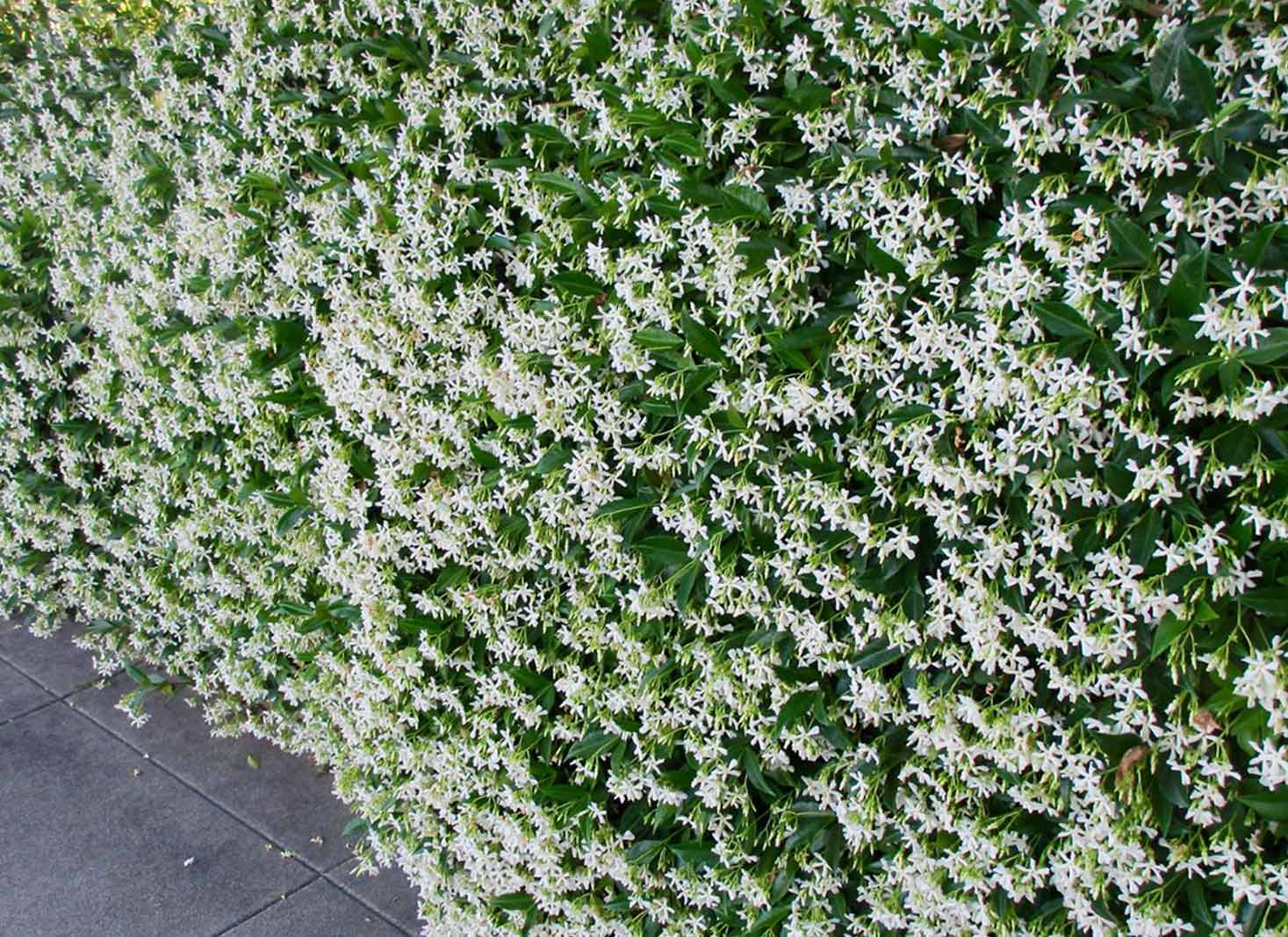
- Temperature; low sunlight, requires shade.
- Soil type; well-drained loamy soil
- pH; low alkaline, neutral to acidic environments
Star Jasmine is also one of the best plants to hide an ugly fence. The plant is not the true jasmine plant, however, it is a close relative. The star jasmine is evergreen and requires very little maintenance. Star jasmines cover up ugly walls by growing in between the posts and chains and blanketing the fence in their leaves. They can also be trimmed into shrubs for shorter fences.
Star jasmines have bright flowers with good perfumes that attract bees and add to a garden fence. They grow well in places with shade against harsh sunlight and in a well-drained loamy soil. They also grow in most soils from low alkaline, neutral to acidic environments.
3. Honeysuckle

- Temperature: full to medium sunlight. They do well in cool climates
- Soil type: all soils even those with poor drainage
- pH; no preference
Honeysuckle is also excellent at hiding an ugly fence. Honeysuckle is the best choice for places with poor soil quality as they grow wherever. The durability of the honeysuckle plant makes it one of the top choices for most gardeners as they have a high chance of thriving in bad soils.
Honeysuckle blooms in spring and produces bright tubular flowers in white and shades of red, yellow, and orange. The Honeysuckle plant grows in vines allowing it to cover tall and short ugly fences. They also do well in cool environments with medium to full sunlight exposure.
4. Clematis

- Temperature; full sunlight for stem and leaves. Needs shade for roots.
- Soil type; any fertile well-drained soil.
- pH; alkaline to a neutral environment.
Clematis also works wonders at hiding an ugly fence. They are climbers and will grow over a fence and hide tall ugly fences very well. There are different species of clematis available but the evergreen species is the best. Evergreen clematis stays green throughout their lifetimes although their flowers fall in the autumn.
There are other species like the dwarf clematis which grows to about 3 feet. This dwarf species can be planted to cover a short ugly fence. The Clematis plant has beautiful pink to purple colored flowers when they bloom. They grow well in sunlight although their roots need shade. Clematis grows well in fertile, well-drained soils within neutral to low alkaline soils.
5. Climbing ivy
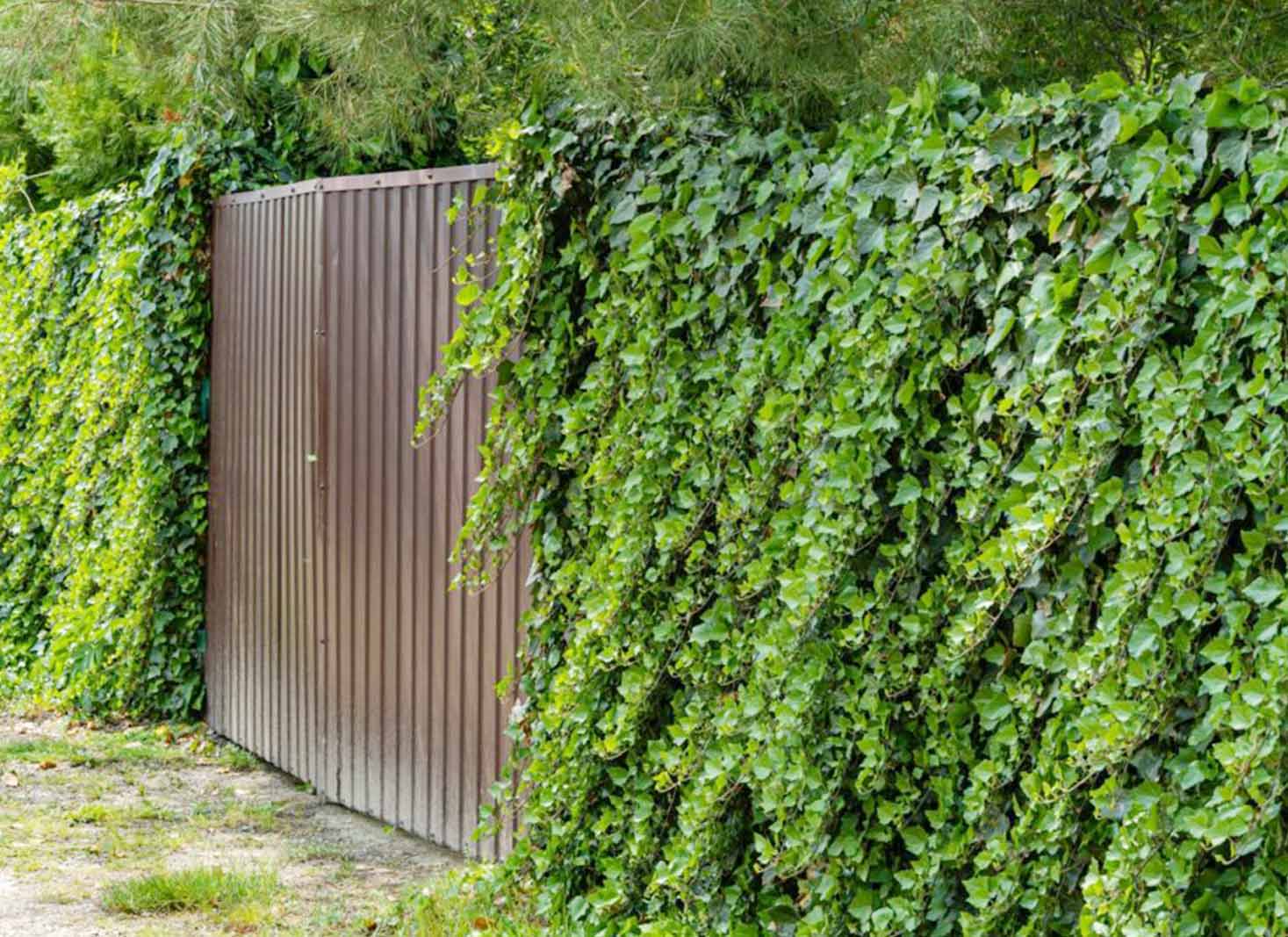
- Temperature; every temperature
- Soil type; every soil
- pH; every pH environment
Climbing ivy is another excellent option for hiding ugly fences.They are one of the most resistant plants to grow and have evolved to grow in almost every environment. Climbing Ivy has aerial roots and can grow without any support from the fence.
If climbing ivy is left they grow very well although occasional trimming will be required to keep the vines from overgrowing the fence.
6. Climbing roses
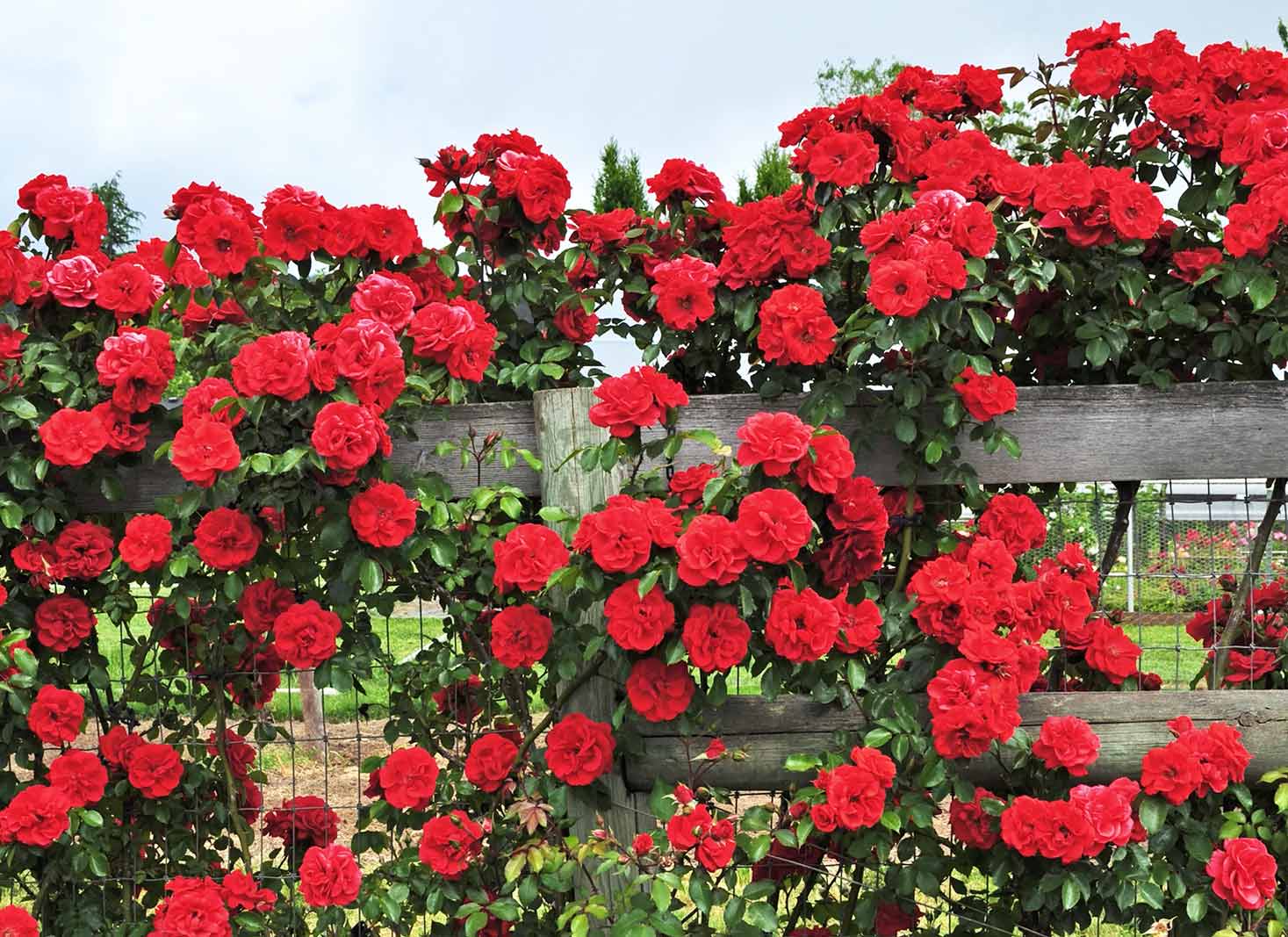
- Temperature; full sunlight
- Soil type; loamy soil
- pH; neutral to low acidic environments
Climbing roses can also hide your unsightly fence and give it a completely new look.They are climbers and sprawlers and will cover an ugly fence by climbing over them and covering up an ugly fence. These plants bloom very beautifully and produce good perfume so they add to the aesthetics of the house and the general look.
Climbing roses require full sunlight exposure in well-drained and fertile loamy soil with a neutral to the low-acid environment.
7. Wisteria

- Temperature: medium to full sunlight. Good for cooler climates.
- Soil type: sandy and loam soil with good water retaining capabilities.
- pH; neutral but can survive in acidic and alkaline
There are many species including the Japanese, Chinese and American wisteria. For wooden fences, use American wisteria as they won’t destroy the wood. Chain link fences can carry and withstand the invasion of the Japanese and Chinese wisteria.
Wisteria blooms in spring and has bright flowers in purple, white, etc. they grow well in medium sunlight and cooler temperatures. They also require lots of water to grow well.
8. Morning glory
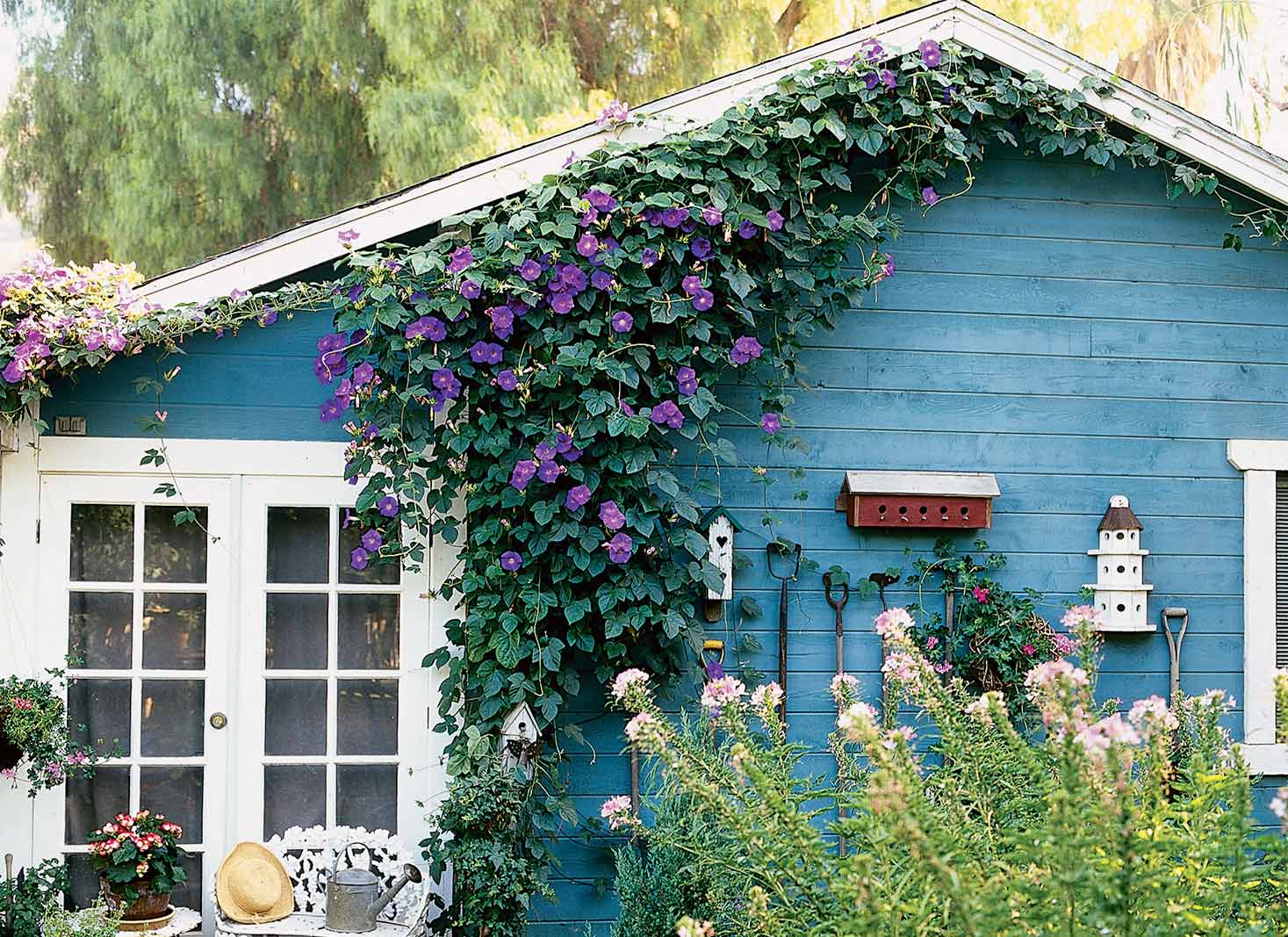
- Temperature; full sunlight
- soil type; grows in all soil types with good drainage
- pH; grows in all pH
The morning glory plant is a creeping vine characterized by its trumpet-shaped flowers that come in the most beautiful blue and purple shades. The flowers bloom every morning with the sunshine and go back in during nighttime. The morning glory plant is a very good choice as the plant can grow in both low and full sunlight areas.
They also grow in almost all soil types as long as it has good drainage and no preferential pH environment. The plant is an easy starter for people looking for an easy plant to hide an ugly fence.
9. Trumpet vines
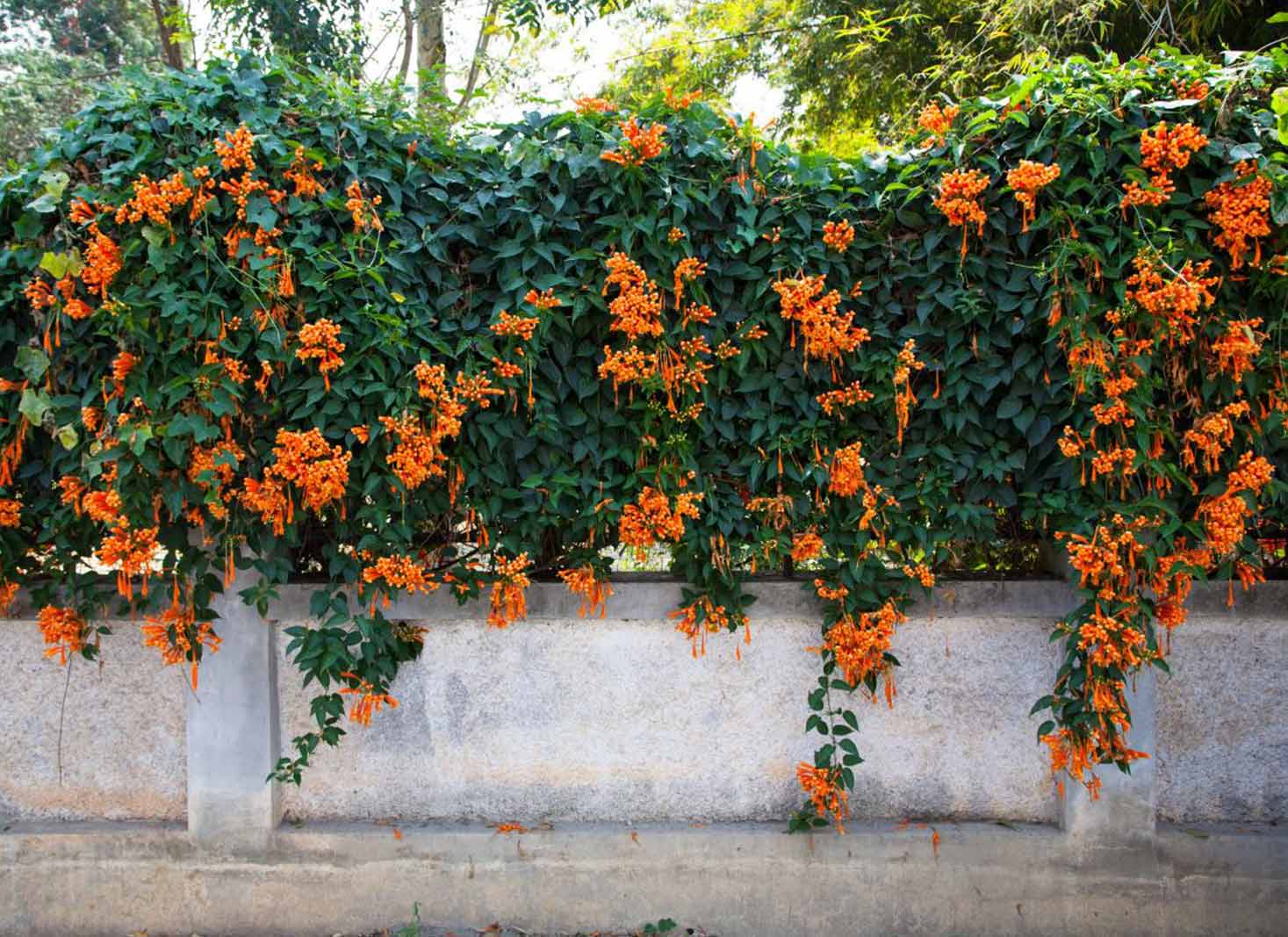
- Temperature: mild sunlight, can grow in cool climates too.
- Soil type: loam soil
- pH; no preference.
Trumpet vines are known for their quick growth and can help you vastly improve an ugly fence quickly. Trumpet vines do not only grow fast but also cover a large surface area and are good for large fences.
The fast growth and large mass of trumpet vines can make it very heavy for small fences. Regular pruning of the vines will manage it very well and keep it managed and light for the fence it is covering. The key to trumpet vines is to provide good support and the fence should be sturdy enough to carry their weight.
10. Hydrangea
- Temperature; full sunlight with partial shade
- Soil type; clay-loam soil
- pH; acidic to neutral to alkaline environments.
Hydrangeas bloom in spring and summer with beautiful blue to purple flowers. This depends mainly on the species of hydrangeas you purchase. Hydrangea requires moisture and sunlight with partial shade from the fence. They grow well in all pH and clay-loam soil.
Climbing hydrangeas are the best choice among all the species as they will cover up an ugly fence. Hydrangeas are a good choice to add color to an ugly fence, especially in the garden area.
Factors to consider when choosing the best plants to hide an ugly fence
Different plants require different biological or chemical factors to stay alive and healthy. When using plants to hide an ugly fence, the idea is to make the fence look nice. However, dead or withering plants will not hide an ugly fence rather it will enhance its ugliness.
Here are some factors to consider when selecting the best plants to hide an ugly fence;
1. The type of material the fence is made of
The material used to make the fence is very important when choosing the best plant to hide an ugly fence. Fences can be made out of wood, chain-link, metal wires, etc and different plants fit perfectly with the different materials.
2. Height of the fence
If the ugly fence to be hidden is tall, then the plant has to be tall enough or grow long enough to conceal the ugly fence. Shorter fences do not need tall plants and some shrubs will do nicely.
3. The space available for planting
The type of plant used to hide an ugly fence will depend on the space available to plant. The best plants to hide usually fences come in different sizes, shapes, and lengths so if the space for planting is cramped, go for creeping plants as vines will be a good option.
4. The temperature of the location
Different plants require different temperatures for good growth. Some areas have lower temperatures while others have warmer temperatures. This means that people that live in colder locations will need different plants from those that live in warmer locations.
5. The humidity of the location
Humidity is the amount of moisture in the atmosphere. Some places have more rainy days while others live in desert towns. Different plants survive in different humidities and choosing the best plants to hide an ugly fence in these locations will depend on whether the plant will do well in that level of humidity.
6. Level of maintenance necessary
Some plants need to be constantly trimmed and maintained to keep the fence looking good. However, many plants require minimal maintenance and grow fairly contained and they are the best plant choice for people with little to no time.
7. Soil type
Different plants grow well in different types of soils. The best plants to hide an ugly fence require the best soil type to grow heather and give the fence the best look. Choosing the best plants to fit the soil type is very important.
The best ways to hide an ugly fence using plants
Choosing the best plants is the first and most important step but putting together the final step makes the biggest difference. You can get the best plants but if they aren’t put together nicely, the fence can end up looking worse than before.
Here are some of the best ways to hide an ugly fence using the best plants.
- You can use the best Plant Bushes or Hedges to hide an ugly fence. This option works well for short fences and will help to keep the kids within your property.
- You can hide an ugly fence by planting many varieties of plants. You can use different plants with different colors of flowers and brighten the fence. This can be done using flower pots and buckets linked to the fence with chains.
- You can plant trees and use them to hide ugly fences. Dwarf trees can be used to hide ugly fences especially when there is a large space available for planting.
- You can plant creeping plants to hide an ugly fence. Fixing a metal wire around the fence and the vines will keep the vines upright and improve the look of an ugly fence.







